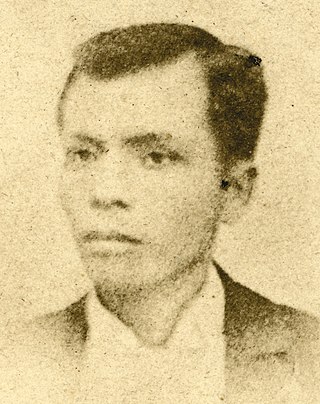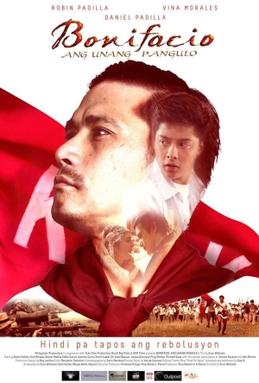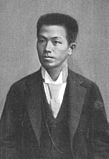
Emilio Aguinaldo y Famy was a Filipino revolutionary, statesman, and military leader who is the youngest president of the Philippines (1899–1901) and became the first president of the Philippines and of an Asian constitutional republic. He led the Philippine forces first against Spain in the Philippine Revolution (1896–1898), then in the Spanish–American War (1898), and finally against the United States during the Philippine–American War (1899–1901).

The Katipunan, officially the Kataastaasan, Kagalanggalang na Katipunan ng mga Anak ng Bayan or Kataastaasan Kagalang-galang na Katipunan ng mga Anak ng Bayan, was a Philippine revolutionary society founded by anti-Spanish colonialist Filipinos in Manila in 1892; its primary goal was to gain independence from Spain through a revolution.

Andrés Bonifacio y de Castro was a Filipino revolutionary leader. He is often called "The Father of the Philippine Revolution", and considered one of the national heroes of the Philippines.

The 1896 Philippine Revolution was a conflict waged by the Filipino revolutionaries against the Spanish colonial authorities in an attempt to win the archipelago's independence. It began on August 24, 1896, when the Spanish authorities discovered the Katipunan, an anticolonial secret organization.
Tagalog Republic is a term used to refer to two revolutionary governments involved in the Philippine Revolution against the Spanish Empire and the Philippine–American War. Both were connected to the Katipunan revolutionary movement.

Mariano M. Álvarez was a Filipino revolutionary and statesman.

Artemio Ricarte y García was a Filipino general during the Philippine Revolution and the Philippine–American War. He is regarded as the Father of the Philippine Army, and the first Chief of Staff of the Armed Forces of the Philippines though the present Philippine Army descended from the American-allied forces that defeated the Philippine Revolutionary Army led by General Ricarte. Ricarte is notable for never having taken an oath of allegiance to the United States government that occupied the Philippines from 1898 to 1946.

Mariano Trías y Closas is considered to be the first de facto Philippine Vice President of that revolutionary government established at the Tejeros Convention - an assembly of Philippine revolutionary leaders that elected officials of the revolutionary movement against the colonial government of Spain. When that assembly broke into factions, a truce known as the Pact of Biak-na-Bato was signed by the group and also recognized the elected officials and Trias as the vice president of Emilio Aguinaldo, who is also considered to be the first President of the Philippines. With the promulgation of the Malolos Constitution by the Malolos Convention, the First Philippine Republic was born. Under the Aguinaldo administration, Trias served in the cabinet initially as Secretary of Finance and, later, as Secretary of War.

Pío del Pilar was a Filipino revolutionary general. He was one of the lead figures in the Philippine Revolution, and fought major battles in Manila and Cavite.

The Magdiwang was a faction of the Katipunan, a Philippine revolutionary organization founded by Filipino rebels in Manila in 1892 with the aim to gain independence from Spain. The Magdiwang Council was acknowledged as "the supreme organ responsible for the successful campaigns against the enemy" within Cavite.

General Licerio Topacio (1839–1925) was a leader in the Philippine independence movement.

The Magdalo was a faction of the Katipunan chapter in Cavite.
Daniel Tirona y Tria was a Filipino politician. He became infamous for causing divisions within the Philippine revolutionary movement and for insulting and maligning Andres Bonifacio during the Tejeros Convention in 1897.
Procopio Bonifacio y de Castro was a Filipino independence activist and revolutionary during the Philippine Revolution of 1896 against Spain. He was a member of the secret revolutionary society turned revolutionary government Katipunan with his other siblings Ciriaco and Espiridiona. His eldest brother Andrés Bonifacio was one of the founders and, eventually, president of the Katipunan.
The Imus Assembly was the meeting held between the Magdalo and Magdiwang factions of the Katipunan at Imus, Cavite, Philippines, on December 31, 1896, the day following the execution of José Rizal. This was convened in order to settle the leadership dispute between the two factions.

The Battle of Binakayan–Dalahican was a simultaneous battle during the Philippine Revolution that was fought on November 9–11, 1896 that led to a decisive Filipino victory. The twin battle took place at the shores of Binakayan, in the town of Cavite Viejo ; Dalahican and Dagatan in Noveleta; and, to minimal extent, in Imus and Bacoor towns in Cavite, Philippines that lasted for two days before the Spanish army retreated demoralized and in disarray. The result of the battle was the first significant Filipino victory in the country's history.

El Presidente: General Emilio Aguinaldo Story and the First Philippine Republic, or simply El Presidente, is a 2012 Filipino biographical film written and directed by Mark Meily about the life of General Emilio Aguinaldo, the first president of the Philippine Republic. The film stars Jeorge "E.R." Ejercito Estregan in the title role, along with Nora Aunor, Christopher de Leon, Cristine Reyes, and Cesar Montano.
The Marangál na Dalit ng̃ Katagalugan is a song of the Philippine Revolution composed in November 1896 by Julio Nakpil at the request of Andres Bonifacio as the anthem of the revolutionary Tagalog Republic. However, this nascent revolutionary government was displaced and superseded by a succession of revolutionary governments headed by Emilio Aguinaldo and the composition known today as Lupang Hinirang became the national anthem of the Republic of the Philippines.

Bonifacio: Ang Unang Pangulo is a 2014 Philippine historical action drama film centering on the life of Katipunan revolutionary Andres Bonifacio. It was an official entry to the 40th Metro Manila Film Festival.
A revolutionary government or provisional government has been declared a number of times in the Philippines, by various insurgent groups.


















